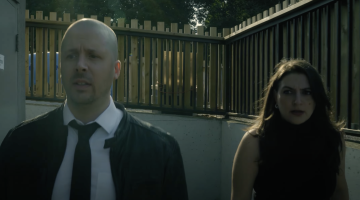When you start learning about screenwriting, one of the first things you’re likely to hear about is the Three Act Structure. With roots tracing back to Aristotle, the Three Act Structure has been championed by everyone from Syd Field to Robert McKee as the standard way to write a feature-length (90-120 page) screenplay. But for those of us writing shorter scripts for web series, applying the three act structure can prove confusing. It may be counterintuitive to try and pack two act breaks into a 5-10 page script, for example. What if your script only has one scene — how are you supposed to pack three acts into a single scene? Faced with these issues, it’s tempting to ignore structure and just try to write something entertaining. But is that really a good idea?
I want to introduce an alternative approach to screenplay structure called the PCR Method. PCR stands for Problem, Complication, and Resolution. I learned this method from Professor Jay Moriarty at USC, who cut his teeth writing for popular 1970s comedies like All In the Family and The Jeffersons. These shows were maybe 25 minutes without the commercials — closer in length to a web series episode than a feature film — so the writers had to develop their stories quickly and hold the attention of finicky viewers clutching remote controls. The structure they perfected is still widely used in half-hour comedies, and can be applied equally well to comedy and drama web series, including episodes that are only a few minutes long.
WRITING USING THE PCR METHOD
1. Start your story with a PROBLEM — some situation that your characters are facing. Problems can be big or small. Maybe an annoying character is coming to visit (Introverts). Maybe your character wants to throw a birthday party for her friend who hates parties (Introverts). Problems don’t have to be negative — maybe your character is going on a date and wants to make a good impression (The Mindy Project) or has the opportunity to stay in a beach house for the weekend (Girls). The important thing is that the problem engages us by creating dramatic tension — hope and fear about what’s going to happen. It doesn’t have to be big or high-stakes (though it certainly can), but it does have to be involving enough to make us care about what happens next.
2. Once you’ve introduced the Problem, add a COMPLICATION. A Complication is exactly what it sounds like — something that shakes things up, making the problem bigger and/or sending it in a different direction. Complications often come just when the characters are close to solving the Problem or at least have it under control. In a half-hour sitcom, the Complication typically occurs right before the act (commercial) break, about halfway in, giving us a reason to sit through the advertisements. With a web series script, there are no hard rules about where to place it — just make sure you bring it in before the story has a chance to stagnate.
3. Finally, you are going to resolve the problem and complication with a RESOLUTION. How you do this will depend on your Problem and Complication. The important thing is that you provide your audience with some sense of completion. “Resolution” doesn’t necessarily mean that the Problem was actually solved. If your character loses a race, that is a Resolution. You get to choose how the story resolves itself and what it means. But there should be a sense that the story has reached its natural conclusion.
In a serialized show, there is often one more story beat — the CLIFFHANGER. This is essentially a new Problem introduced at very end of the episode that is left unresolved — which has the effect of making us want to watch another episode. Hopefully this sounds simple enough — and it is. You’ve likely seen this structure played out dozens or hundreds of times in all kinds of shows. It works equally well in web series episodes. Here are some examples (spoiler alert):
EXAMPLES
Mermates 1.1: “The Apartment”
Problem: Chris needs to find a new apartment.
Complication: He finds the perfect place — but the roommate thinks he’s a mermaid.
Resolution: Chris decides to take the apartment anyway.
The initial introduction of William the Mermaid in Mermates is a classic complication — Chris finds what seems to be the perfect apartment, but the new roommate thinks he’s a mermaid.
Introverts 1.3: “The Meet Cute”
Problem: Amy meets a charming guy on a park bench.
Complication: Marissa stops to chat, diverting the guy’s attention.
Resolution: The guy asks for Marissa’s number instead of Amy’s. This is an example of a “good” problem — a handsome guy sits next to Amy. It works because we feel involved in the outcome of the story at this moment, i.e. will she be able to get to know the guy better?
00c6 1.1: “Island #c001”
Problem: The main character wakes up on a strange beach.
Complication: A man appears suddenly and attacks him. He fights back and kills the man.
Resolution: The main character removes what appears to be a tracking device from his chest. This episode illustrates how PCR concepts apply to any genre of story and can be conveyed without a single line of dialogue.
Least Favorite Love Songs 1.2: “Jacob, the job interview”
Problem: Molly learns about a job lead at a magazine.
Complication: Due to a phone glitch, Molly’s potential new boss confuses her with a dominatrix he’s supposed to interview for a story.
Resolution: After clearing things up, Molly lands the job.
Cliffhanger: Her first assignment is to interview her new crush, Calliope.
This is another “good” problem – Molly has the chance to get a job – which was actually introduced at the end of the last episode as a cliffhanger. There is also a secondary cliffhanger in the introduction of the new boss as a love interest.
THE PCR METHOD IN CONTEXT
I started off suggesting that the PCR Method is an alternative to the Three Act Structure, but it’s more accurate to say that the PCR Method is a way of describing the three-act structure. The Problem is Act 1, the Complication is Act 2, and the Resolution is Act 3. So why think in terms of Problem-Complication-Resolution? Because the words make you think differently about what you’re doing. In particular, when working in short form, I find it helpful to think in terms of starting with a “Problem,” which creates immediate interest, rather than a “set-up” (which implies a much more leisurely pace).
Does that mean every short script has to use the PCR method? No. Some half-hour shows like Louie, Portlandia, and newer episodes of The Simpsons don’t have PCR structures (though they often contain segments that break down into PCR). If your script engages viewers and sustains viewer interest through the entire episode, you can do whatever you want. But the PCR method is a reliable and adaptable way to do exactly that. Next time you are trying to develop a story, give it a try.










No Comment